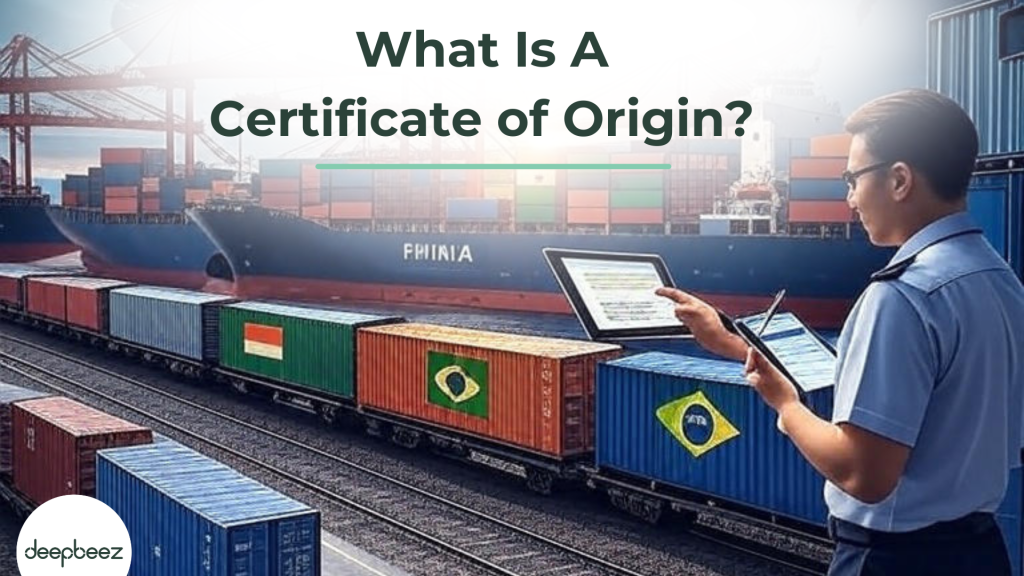Certificate of origin meaning? Think of a Certificate of Origin as your product’s “birth certificate” for international trade. It’s an official document that declares the “nationality” of your goods – essentially telling the world where your products were made or originated.
Here’s what makes COs unique: they’re one-time documents. This means you need a fresh certificate for every single shipment, even if you’re sending the exact same product to the same destination. No exceptions!
What Is the Purpose of Certificate of Origin?
You might be wondering, “Why all this paperwork?” Well, COs serve several critical purposes that keep international trade running smoothly:
- Customs Compliance: They help verify that traders are following customs and tariff requirements
- Preferential Treatment: They determine if your goods qualify for special tariff rates under trade agreements
- Trade Security: They ensure products aren’t coming from countries under trade sanctions
- Duty Calculation: Customs officials use them to calculate fees and import duties
- Transparency: They provide complete visibility into where goods are coming from and going
Have you ever received a package from overseas and noticed how quickly it cleared customs? Chances are, proper documentation like a CO helped speed up that process!
Two Main Types of Certificates of Origin for Shipping
Not all Certificates of Origin are created equal. There are two distinct types, each serving different purposes in international trade:
| Type | Purpose | Benefits | Common Use Cases |
| Non-Preferential (Ordinary) | Indicates standard commercial origin | No special tariff benefits | Countries without trade agreements, excluded products |
| Preferential | Qualifies for reduced/eliminated tariffs | Significant cost savings | Free trade agreements (USMCA, EU agreements, GSP) |
1- Non-Preferential Certificates of Origin
These are the “standard” certificates – think of them as the baseline option. Non-preferential COs:
• Don’t provide tariff benefits – your goods pay regular import duties
• Focus on commercial origin – they simply state where the product was made
• Are most common – the majority of COs fall into this category
• Still matter – importing countries may require them for policy reasons, anti-dumping measures, or safety concerns
Important note: For goods to qualify as originating from a specific country (like India), they must either be wholly manufactured there or undergo substantial processing if imported materials are used. Simple operations like washing, painting, repackaging, or basic assembly typically don’t count as “originating.”
2- Preferential Certificates of Origin
Now we’re talking about the money-saving certificates! Preferential COs are your ticket to:
- Reduced tariffs or complete duty elimination
- Access to special trade programs like the U.S. Generalized System of Preferences (GSP)
- Competitive advantages in international markets
Real-world example: If you’re shipping goods between the U.S., Mexico, and Canada under the USMCA agreement, a preferential CO could eliminate thousands of dollars in import duties. Similarly, EU businesses trading with partner countries might use EUR.1 or EUR-MED forms.
Did you know that over 100 developing countries currently benefit from GSP status? Countries like Bolivia, Cambodia, Haiti, Namibia, and Pakistan can export thousands of products to the U.S. duty-free thanks to preferential COs!
What Information Is Included on a Certificate of Origin?
A Certificate of Origin is like a detailed ID card for your shipment. While there’s no universal standard format globally, most COs include these essential elements:
| Information Category | Details Required |
| Producer Information | Name, address, and contact details of the manufacturer |
| Exporter Information | Name and contact details of the shipping agent |
| Importer Information | Name and contact details of the receiving party |
| Goods Description | Detailed product description with appropriate codes |
| Quantity Details | Weight, size, and quantity of items |
| Transportation Info | Bill of lading number, route, and transport method |
| Commercial Invoice | Dated invoice with financial transaction details |
| Tariff Code | Specific tariff classification for the products |
| Official Verification | Digital signature and issuing authority validation |
Online certificate of origin? many countries are moving toward electronic COs! In the U.S., for example, exporters can now obtain digital certificates from the American World Trade Chamber of Commerce (AWTCC). These electronic certificates can be verified instantly worldwide – no more waiting for physical documents to arrive!
For Export and Import What Is a Certificate of Origin?
When Do You Actually Need a Certificate of Origin? This is probably the question you’ve been waiting for. The short answer? It depends on where you’re shipping and what you’re shipping. But let’s break it down:
1- Meeting Import Regulations
Different countries have different rules. Some require COs for specific product categories, while others want them for everything. The decision ultimately lies with the destination country’s customs authority.
2- Claiming Preferential Treatment
If you want to take advantage of reduced tariffs under trade agreements, you’ll definitely need the appropriate preferential CO. Missing this document could cost you significant money in unnecessary duties.
3- Compliance with Trade Policies
COs help enforce:
- Trade sanctions – ensuring goods don’t come from restricted countries
- Anti-dumping measures – preventing unfair pricing practices
- Import quotas – managing the quantity of specific goods entering a country
- Environmental protection – monitoring trade in endangered species
4- Financial and Legal Requirements
Sometimes your customer’s bank or letter of credit will specifically require a CO. In other cases, your buyer might need it for their own compliance purposes.
Pro tip: Always coordinate with your customer to confirm what documentation they need. It’s much easier to get this right the first time than to deal with shipment delays later!
Which Countries Require Certificates of Origin?
While there’s no universal list (since requirements change frequently), certain regions are known for requiring COs:
| Region | Common Requirements |
| Middle East | Often requires COs for most imports |
| Africa | Many countries mandate COs for customs clearance |
| Asia | Countries like China, India, Malaysia, and Singapore frequently require COs |
| Eastern Europe | Various countries require COs depending on product type |
Who Issues Certificates of Origin?
Getting your CO from the right authority is crucial – an invalid certificate can cause serious delays and complications.
Standard Issuing Authorities
Chambers of Commerce are your primary go-to source in most countries. To apply, you typically need:
- A business or residential address within the chamber’s jurisdiction
- Proper documentation about your goods and business
- Payment of applicable fees
In the United States
The U.S. has modernized its CO system:
- American World Trade Chamber of Commerce (AWTCC) handles electronic COs
- ICC accreditation ensures worldwide recognition
- Online registration system makes the process faster and more efficient
For Different Types of COs
Preferential COs: These require authorization from specific agencies designated for particular trade agreements. In India, for example, the DGFT website lists all authorized agencies for different FTAs and PTAs.
Non-Preferential COs: These can typically be issued by chambers of commerce or other notified agencies in your country.
FAQ
- My shipment got rejected because of a CO error. What went wrong?
Most rejections happen due to mismatched product descriptions between your CO and commercial invoice, incorrect country of origin (listing assembly country instead of manufacturing country), or missing additional certifications like embassy authentication. Double-check all details match exactly across documents before submitting. - Do I really need a new Certificate of Origin for every single shipment?
Yes, COs are one-time documents – you need a fresh certificate for every shipment, even if it’s the exact same product to the same destination. However, you can use “blanket certificates” that cover multiple shipments of identical goods within a 12-month period. - I’m confused about preferential vs non-preferential COs. Which do I need?
Non-preferential COs are standard certificates that don’t provide tariff benefits – most COs fall into this category. Preferential COs are for goods qualifying under free trade agreements for reduced or eliminated duties. If your goods qualify under FTAs like USMCA, EU agreements, or GSP, go preferential to save money. - Can I just write “manufactured goods” or “spare parts” in the product description?
No! Avoid vague descriptions like “spare parts” or brand names. Describe your goods in sufficient detail to clearly indicate their nature. Customs needs specific details to classify and assess duties properly. Be descriptive but concise. - My customer is asking for a CO but I’m not sure if their country requires it. How do I check?
Use the Market Access Database (MADB) for EU exports or Access2Markets by entering your origin country, destination country, and HS Code. Many Middle Eastern and West African countries don’t accept cargo from certain countries without a CO, so it’s often safer to have one. - Who can actually issue a Certificate of Origin? Can I do it myself?
Only exporters can issue a CO, but it typically needs endorsement by a Chamber of Commerce or authorized authority. Some FTAs allow self-certification, but most require third-party validation. Your local Chamber of Commerce is usually your best bet. - I heard about electronic COs. Are they as valid as paper ones?
Yes! In the U.S., electronic COs from the American World Trade Chamber of Commerce (AWTCC) display ICC accreditation and can be verified worldwide. Most FTAs don’t require hard copies anymore. Electronic is often faster and more convenient. - My goods use materials from multiple countries. How do I determine the “country of origin”?
For goods involving multiple countries, origin is determined by where the last substantial, economically-justified processing occurred that resulted in a new product or important manufacturing stage. Use the “tariff test” – if your final product has a different tariff code than the input materials, it’s likely manufactured in your country. - How much does getting a Certificate of Origin cost and how long does it take?
Costs vary by country and issuing authority – typically $25-100 per certificate. Electronic COs through systems like AWTCC can be processed much faster than traditional paper certificates. Allow 2-5 business days for processing, though electronic systems can be same-day. - I’m shipping from the US to Canada under USMCA. Do I need a special form?
USMCA (which replaced NAFTA) uses uniform certificates printed in English, French, or Spanish. The certificate can be completed in the language of the exporting or importing country. No specific hard copy format is required – many accept declarative statements with required data elements. - What happens if I made a mistake on my CO after it’s already been issued?
You must notify all parties who received the certificate of any changes that could affect its accuracy or validity. Customs may allow corrections or appeals if supported by valid documentation, but you might face penalties for false declarations. Act quickly to minimize delays. - How long do I need to keep records related to my Certificate of Origin?
Exporters and producers must maintain CO-related records for five years or longer as specified by their countries. This includes production records, supplier declarations, and copies of issued certificates. Keep everything organized for potential audits. - My buyer wants a CO but we don’t have any trade agreement. Is it worth it?
Even without tariff benefits, a CO may still be beneficial if the standard duty rate differs by country of origin. COs are often required for statistical, regulatory compliance, or anti-dumping purposes. If your buyer requests it, there’s usually a good reason. - I export the same product to multiple countries. Can I use the same CO for all of them?
No! FTA benefits aren’t transferable. Just because a product qualifies for one FTA doesn’t mean it qualifies for another, and you can’t use the same certificate for different FTA countries. Each destination may have different requirements and formats. - What’s the difference between “wholly obtained” and “manufactured” on the CO form?
“Wholly obtained” goods are made from raw materials from that country (vegetables, minerals, animals born and raised there). “Manufactured” goods have gone through a manufacturing process that confers origin status. Simple operations like washing, painting, or basic assembly typically don’t count as manufacturing.





